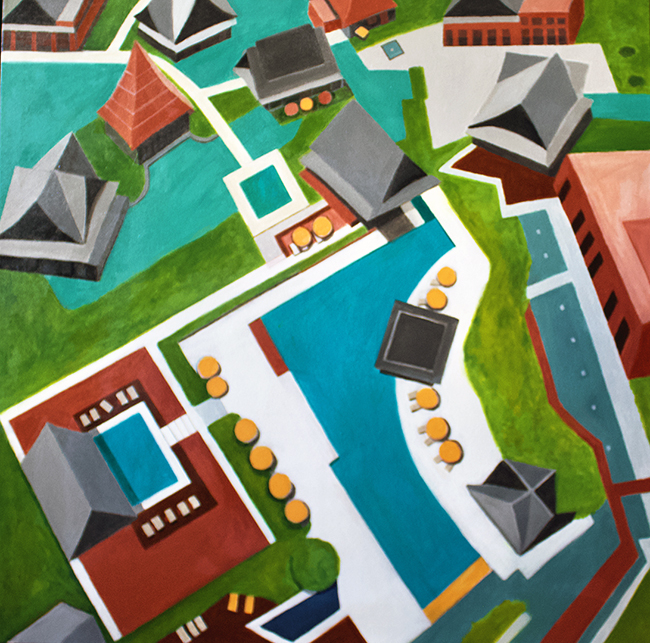Born in the vibrant city of Philadelphia, Toni Silber-Delerive is an artist whose path through the fine arts has been anything but static. BFA in painting from the Philadelphia College of Art, followed by a MA in art education from Kean College in New Jersey. Her curiosity and drive for experimentation didn’t stop there—she went on to study graphic design and silkscreen printing at the renowned School of Visual Arts in New York City. That mix of disciplines—painting, design, and printmaking—gave her work a clear sense of balance between painterly freedom and structured composition. Silber-Delerive’s art reflects her fascination with how we see the world—especially from above. Her aerial perspectives turn familiar places into abstract studies of pattern, rhythm, and human order.
Chinese Houses
Acrylic on canvas, 36” x 36”

In Chinese Houses, Silber-Delerive takes us high above a neighborhood that feels both distant and strangely familiar. The view is straight down—no horizon, no figures, no sound. Just a calm geometry of rooftops, waterways, and muted colors. The scene unfolds like a map someone forgot to label. A cluster of pagoda-style houses fills the square canvas, arranged around pools and winding water channels. From this height, everything flattens and organizes itself into patterns. The repetition of roofs becomes almost hypnotic, like a quiet mantra of architecture and design.
Her use of color is soft yet deliberate—warm neutrals and cool blues that create a steady visual rhythm. It’s not about drama or grandeur; it’s about structure and stillness. By stripping away unnecessary detail, Silber-Delerive lets the composition breathe. The lines and shapes talk to each other. The pools of water act as pauses between words, giving the eye somewhere to rest before jumping back into the maze of rooftops.
There’s something oddly peaceful about the absence of people here. The painting feels suspended in time, as if the neighborhood has stopped to take a deep breath. This quiet abandonment isn’t sad—it’s meditative. It invites you to think about how we occupy space, and what it looks like when we’re not there to fill it. You can almost hear the hum of the earth below, or the faint echo of life that once moved through those narrow streets.
Silber-Delerive has a knack for turning the ordinary into something contemplative. Her aerial works often play with that tension between design and life. The higher she lifts the perspective, the more the human element becomes abstract—transformed into symbols of rhythm and pattern. In Chinese Houses, that tension feels especially alive. The buildings are almost identical, but not quite. Each roof, each shadow holds a small difference, reminding us that even in repetition there’s individuality.
The composition’s flatness recalls both cartography and modernist painting. You could see hints of early abstraction in the way she organizes space—think Diebenkorn’s aerial grids or Milton Avery’s simplified landscapes—but her sensibility is more narrative. She’s not chasing pure form. She’s observing how environments reflect culture and collective identity. The pagoda roofs are instantly recognizable markers of place, and yet, in her hands, they become universal—part of a broader story about human settlement and design.
Her brushwork stays controlled, leaning more toward graphic precision than gestural freedom. You sense her background in design—each edge is crisp, each transition intentional. Still, the surface holds warmth. It’s not mechanical. The paint has presence, and that gives the scene its emotional pull. You’re aware of both the distance and the care behind the image.
What’s cool about Silber-Delerive’s aerial perspective is how it flips the viewer’s role. Instead of walking through a scene, you’re floating above it, detached but curious. That shift in viewpoint changes everything—it turns a village into an abstract composition, and an everyday neighborhood into something poetic. Chinese Houses works as both landscape and meditation, as both documentation and design.
The painting’s stillness feels earned. It’s not emptiness—it’s observation. Silber-Delerive captures that quiet moment when the world organizes itself into pattern, when chaos reveals its hidden order. From above, the noise of life fades away, and what remains is form, rhythm, and color—simple elements holding deep meaning.
In Chinese Houses, you see the beauty of human construction, but also its fragility. The architecture stands strong, yet the silence hints at impermanence. Silber-Delerive gives us both—the precision of man-made order and the dreamlike calm of nature’s pause. The result is a painting that feels timeless, thoughtful, and quietly mesmerizing.

